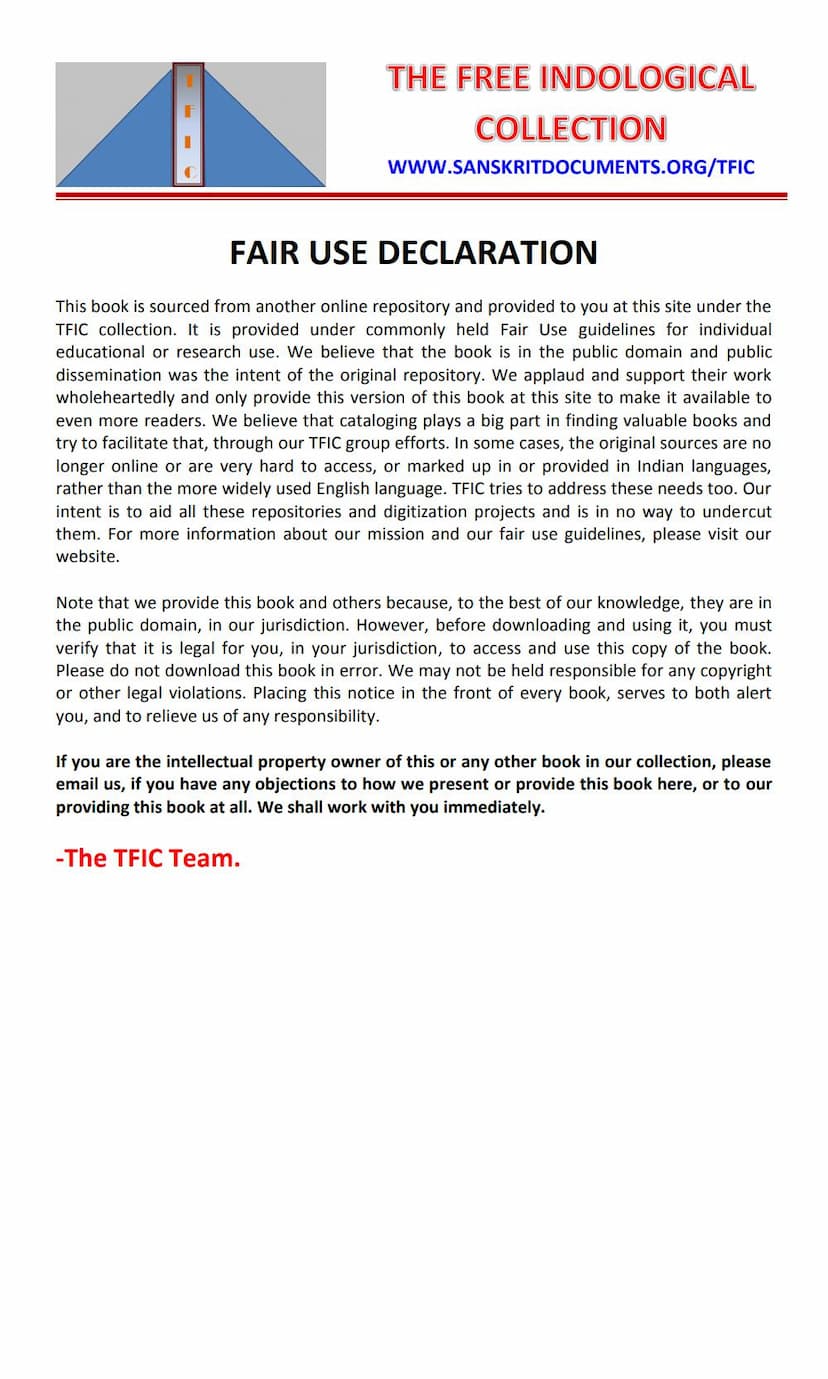Ancient Jaina Hymns
Added to library: September 1, 2025

Summary
Here's a comprehensive summary of "Ancient Jaina Hymns" by Charlotte Krause, based on the provided text:
Overview:
"Ancient Jaina Hymns," published by the Scindia Oriental Institute in Ujjain in 1952, is a scholarly work critically edited by Dr. Charlotte Krause. The book presents a collection of eight heretofore unpublished hymns of Svetambara Jaina origin. Beyond their literary merit, these hymns are significant for the historical, geographical, and biographical insights they offer into Jainism, particularly concerning forgotten saints and poets. The work aims to make this valuable hymnological literature accessible to a wider audience of Indologists.
Key Components of the Book:
-
Introduction: This section provides a detailed exposition of Jaina cosmology, cosmography, and the concept of Tirthankaras (spiritual guides). It explains the Jaina understanding of the universe, the different "worlds" (dvipas), and the cyclical nature of time (Kālacakra) with its periods of advancement (Utsarpini) and decline (Avasarpini). The introduction also delves into the biographies and characteristics of the 24 Tirthankaras, including their genealogies, birthplaces, physical attributes, and the miraculous phenomena associated with them (atisayas). It discusses the concept of "Karmabhūmis" and "Bhogabhūmis" and explains the significance of Tirthankaras in the pursuit of salvation.
-
Remarks on the Texts: This is the core analytical part of the book, where each of the eight hymns is discussed in detail.
- 1. The Munisuvrata-stavana: This hymn is addressed to the 20th Tirthankara, Munisuvrata. The commentary highlights its references to Munisuvrata's previous nine existences and his life as a Tirthankara, including his physical characteristics and the associated miracles. Significantly, it discusses the historical importance of the "Asvāvabodha-tirtha" at Broach, which is described as a flourishing pilgrimage site in the hymn, representing the last known record of its existence. The detailed historical tracing of the shrine's restorations and eventual fate is a major focus.
- 2. The Devakulādinātha-stavana: This hymn is dedicated to Adinatha (Rishabhanatha), the first Tirthankara. The remarks focus on the hymn's address to a specific image of Adinatha at "Devakula" (modern Delwara near Udaipur), a place renowned for its numerous ancient Jaina temples. It notes the hymn's connection to the Acāryas Somasundara Suri and Munisundara Suri, placing its composition in the late 15th or early 16th century.
- 3. The Varakāna-Pārsvanātha-stavana: Authored by Hemavimala Suri, this hymn is addressed to Pārsvanatha. The extensive remarks detail Hemavimala Suri's life and career as a prominent Tapā Gaccha pontiff. The hymn itself is analyzed as a "samasyā-pūraṇa" (a poem built upon existing lines), skillfully weaving together lines from the renowned "Kalyāṇa-mandira-stotra" and "Bhaktāmara-stotra." It also discusses the famous Pārsvanatha image at Varakana in Marwar.
- 4. The Sankhesvara-Pārsvanātha-stavana: This hymn by Nayavimala (Jñānavimala Suri) is addressed to Pārsvanatha at the famous Sankheshvara pilgrimage site. The remarks trace Nayavimala's lineage and career within the Tapā Gaccha. The hymn's opening with "Aindra" and its connection to the philosopher-poet Yasovijaya are explored. The commentary also delves into the significance of the mantras addressed to Pārsvanatha and his attendant goddess, Padmavati.
- 5. The Tirthamālā-caityavandana: This short, anonymous Sanskrit hymn is notable for listing numerous ancient Jaina pilgrimage sites across India. The remarks meticulously identify these sites, distinguishing between genuine geographical locations and mythological ones, and discuss their historical prominence and current status. The analysis suggests the hymn dates back several centuries.
- 6. The Vira-stuti: This hymn celebrates Mahāvira, the last Tirthankara, and is characterized by its use of onomatopoeia to represent musical performances associated with the Tirthankara's sermons. The remarks compare it to a similar hymn by Jinakusala Suri and discuss the invocation of the goddess Vairotya, exploring her complex identity and associations in Jaina mythology.
- 7. The Mahāvira-stuti: Attributed to Jinapati Suri, an influential pontiff of the Kharatara Gaccha, this hymn praises Mahāvira and invokes the Yaksa Sarvanu. The remarks discuss Jinapati Suri's prolific literary output and the potential identity of Sarvanu.
- 8. The Simandhara-stavana: This hymn is addressed to Simandhara, one of the Tirthankaras believed to be alive and preaching in Mahavideha. The remarks focus on the hymn's linguistic analysis, identifying it as a transitional form between Gaurjara Apabhramsa and early Middle Gujarati. The poet's desire to be reborn in Mahavideha and to follow Simandhara is highlighted.
-
The Texts: This section presents the critical editions of the eight hymns in Sanskrit and Apabhramsa, complete with the original verses.
-
Critical Apparatus: This provides detailed notes on the manuscript readings, corrections, and conjectures made during the textual editing process for each hymn.
-
Notes: These offer explanations of Jaina philosophical and cosmological terms, clarify historical references, and elaborate on points made in the "Remarks on the Texts."
-
Bibliography: This extensive list provides a comprehensive bibliography of Jaina literature and related scholarly works consulted by the author, crucial for understanding the context and sources of the hymns.
-
Corrigenda: This section lists corrections to any typographical or editorial errors found in the preceding text.
Overall Significance:
"Ancient Jaina Hymns" is a significant contribution to Indological studies and Jaina scholarship. It not only preserves and elucidates rare and valuable hymnological texts but also provides critical historical and linguistic context. Dr. Krause's meticulous research illuminates aspects of Jaina tradition, mythology, and history that were previously obscure, making the book an indispensable resource for scholars and enthusiasts of Jainism and ancient Indian literature.